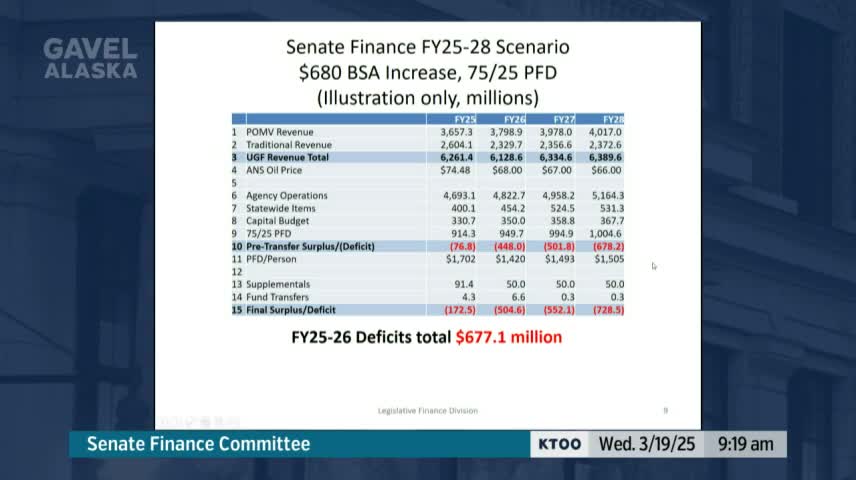House budget plan reveals rising annual deficit projections for FY 2028
March 19, 2025 | 2025 Legislature Alaska, Alaska
This article was created by AI summarizing key points discussed. AI makes mistakes, so for full details and context, please refer to the video of the full meeting. Please report any errors so we can fix them. Report an error »

The Alaska State Legislature's Senate Finance Committee convened on March 19, 2025, to discuss pressing budgetary concerns, particularly the growing deficit and its implications for the Permanent Fund Dividend (PFD).
The meeting began with a review of the current budget scenarios, highlighting the House's version that incorporates a balanced budget approach. It was noted that the calculations for this balanced budget do not include supplemental appropriations, leading to an anticipated annual deficit of $50 million. This scenario mirrors previous budget discussions but emphasizes the importance of maintaining balanced budgets each year.
A significant point of concern raised during the meeting was the projected decline in the PFD. The committee discussed how the PFD, which is crucial for many Alaskans, would remain relatively stable between fiscal years 2026 and 2027 but is expected to drop sharply in fiscal year 2028. This decline is attributed to the state's reliance on the PFD to offset the growing deficit. The committee members expressed alarm over the potential elimination of the dividend within a decade if current budget strategies continue.
In response to these challenges, the committee acknowledged the need to explore additional revenue sources. However, they emphasized that substantial work remains to be done before finalizing the budget for fiscal year 2025.
The meeting concluded with a commitment to further analyze the budget implications and seek solutions to ensure the sustainability of the PFD and the state's financial health. The discussions underscored the urgency of addressing the deficit while balancing the needs of Alaskan residents.
The meeting began with a review of the current budget scenarios, highlighting the House's version that incorporates a balanced budget approach. It was noted that the calculations for this balanced budget do not include supplemental appropriations, leading to an anticipated annual deficit of $50 million. This scenario mirrors previous budget discussions but emphasizes the importance of maintaining balanced budgets each year.
A significant point of concern raised during the meeting was the projected decline in the PFD. The committee discussed how the PFD, which is crucial for many Alaskans, would remain relatively stable between fiscal years 2026 and 2027 but is expected to drop sharply in fiscal year 2028. This decline is attributed to the state's reliance on the PFD to offset the growing deficit. The committee members expressed alarm over the potential elimination of the dividend within a decade if current budget strategies continue.
In response to these challenges, the committee acknowledged the need to explore additional revenue sources. However, they emphasized that substantial work remains to be done before finalizing the budget for fiscal year 2025.
The meeting concluded with a commitment to further analyze the budget implications and seek solutions to ensure the sustainability of the PFD and the state's financial health. The discussions underscored the urgency of addressing the deficit while balancing the needs of Alaskan residents.
View full meeting
This article is based on a recent meeting—watch the full video and explore the complete transcript for deeper insights into the discussion.
View full meeting
